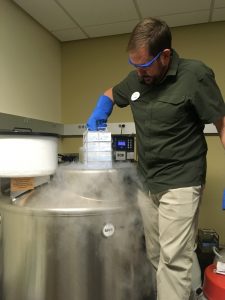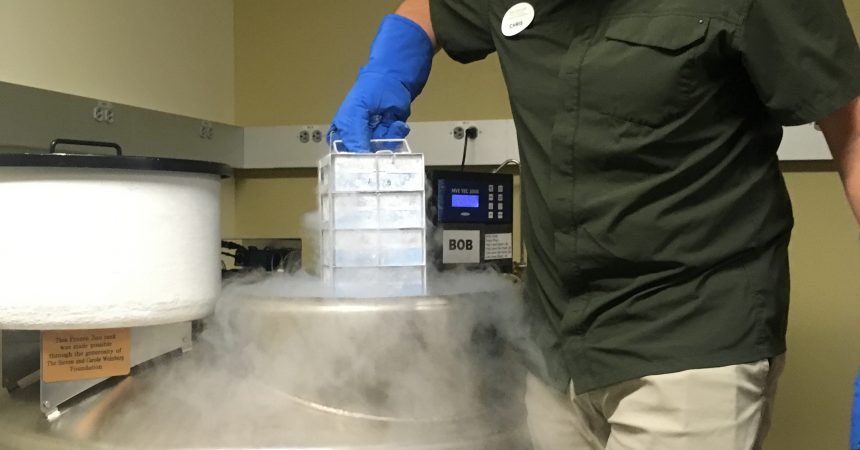Zoo InternQuest is a seven-week career exploration program for San Diego County high school juniors and seniors. Students have the unique opportunity to meet professionals working for the San Diego Zoo, Safari Park, and Institute for Conservation Research, learn about their jobs, and then blog about their experience online. Follow their adventures here on the Zoo’s website!
 Dr. Tubbs is the Senior Scientist for the Reproductive Sciences team at the San Diego Zoo Institute for Conservation Research. Dr. Tubbs earned his bachelor’s degree in Zoology from the University of Florida and his doctorate from the University of Texas, Austin. For his doctorate, Dr. Tubbs studied fish sperm motility. At the San Diego Zoo, Dr. Tubbs is using his research to develop new reproductive technologies. However, Dr. Tubbs does not do this alone, he attributes a lot of the successes that the Reproductive Sciences team has had to his coworkers at the Institute and the partnerships the Zoo has been able to cultivate with other zoos across the nation.
Dr. Tubbs is the Senior Scientist for the Reproductive Sciences team at the San Diego Zoo Institute for Conservation Research. Dr. Tubbs earned his bachelor’s degree in Zoology from the University of Florida and his doctorate from the University of Texas, Austin. For his doctorate, Dr. Tubbs studied fish sperm motility. At the San Diego Zoo, Dr. Tubbs is using his research to develop new reproductive technologies. However, Dr. Tubbs does not do this alone, he attributes a lot of the successes that the Reproductive Sciences team has had to his coworkers at the Institute and the partnerships the Zoo has been able to cultivate with other zoos across the nation.
These partnerships are extremely important in the work that is being done at the Zoo. In order for the Zoo to maintain stable and genetically diverse rhinos in managed care, it is important that zoos have the ability to exchange male and female rhinos to promote healthy reproduction. The San Diego Zoo works in conjunction with a variety of Species Survival Plans (SSP’s) in order to work with other zoos to help save endangered species around the world. Part of Dr. Tubbs’ job at the Institute is working with representatives who manage the southern white rhino SSP, in order to get the necessary resources the San Diego Zoo need to conduct their research. Chris participates in various committee meetings of the SSP to discuss the needs of the San Diego Zoo as well as how the Zoo can help other institutions with their research.
In addition to aiding the national effort to save species using reproductive science, Dr. Tubbs and his team conduct their own research. Part of this research utilizes samples preserved in the San Diego Zoo’s Frozen Zoo. The Frozen Zoo houses frozen DNA samples that were taken from a multitude of mammal, bird, and reptile species. This is vitally important to the conservation of endangered species because one day cells harvested from extinct species can potentially be used to continue research. Furthermore, through reproductive sciences, Dr. Tubbs and his team can use the existing 12 cell lines from northern white rhinos including samples of egg and sperm. From these samples , it is San Diego Zoo Global’s hope that embryos can be created in a lab setting. Once the science is sound, these embryos can then be implanted into northern white rhino’s close relative, the southern white rhino, through in vitro fertilization. It is the Zoo’s goal that this can potentially bring back the northern white rhino from a population of two, to hopefully one day, a flourishing population in the wild. At the Zoo’s Rhino Rescue Center, artificial inseminations have already been done and have resulted in two pregnancies. One of the rhino’s is 180 days pregnant, while the other is only 60 days. These female rhinos moms will be expected to give birth after about 16 months of pregnancy, which gives the Zoo plenty of time to prepare for the new additions to the herd. However, the Zoo’s Reproductive Sciences team does not just make babies. They play a huge role in tracking pregnancy and ovulation patterns in animals at both the Zoo and Safari Park.
Endocrinology is vital in testing for pregnancy and ovulation in wild animals. Endocrinology is the study of hormones. Given that there isn’t an instant pregnancy test for many species of animals, scientist studying reproduction in wild animals closely monitor hormones as a way to tell if an animal might be pregnant or ovulating. In order for pregnancy, ovulation and animal’s fertility, scientists monitor a hormone called progesterone. More specifically, progesterone levels become elevated in animals that are pregnant or ovulating. This information can allow the Zoo to prepare for when a new baby is joining the family.
Given that there is still some resistance to new reproductive technologies, such as the use of cryogenics and cloning, one of Dr. Tubbs duties is to make sure the research being conducted is ethical. One of the struggles with the Northern White Rhino Project is how does the Zoo meet the goals of the project while being minimally invasive? For example, scientists in the Reproductive Sciences team are studying feces and urine samples rather than taking large quantities of blood from these animals. This allows scientists to get the resources they need while being respectful and minimally invasive towards these animals.
Despite the many challenges that face Dr. Tubbs and his field of study, he continues his work to save species populations. Dr. Tube has recently returned from a trip to South Africa where he studied wild rhino diets, collecting samples of colon microbes to compare with the rhinos at the Zoo as a means to gather more information regarding nutrition and reproductive health. This study has lead to the San Diego Zoo changing the diets of their rhinos to be more like those in the wild. This week Dr. Tubbs will be in Baja California to conduct research on California Condors and continue his work to use Reproductive Science to help endangered species.
Good luck, Dr. Tubbs!
Casey, Careers Team
Week two, Fall Session 2018


